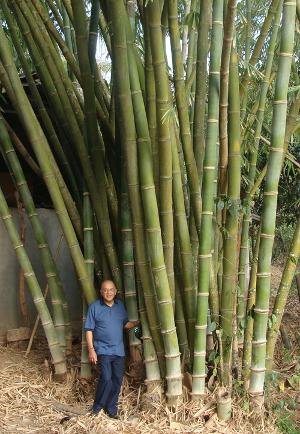Though bitter in taste if eaten raw, Dendrocalamus brandisii in Coorg has been since slowly making it to the local menu
Till recently, it was like any other species of bamboo that dotted the vegetation. The locals have for long a fair penchant for the edible varieties of bamboo shoots but no liking for the abundantly available Burma bamboo. Nobody dared to give the bamboo shoot a try for fear of it being poisonous.
The turning point, however, came when a team of scientists from Institute of Wood Science and Technology (IWST) in Bangaluru visited Coorg to propagate the vegetarian properties of Dendrocalamus brandisii. Based on their over a decade long research on the Burma bamboo species, for the first time it was disclosed that bamboo shoot eschewed by the people of Coorg and adjoining areas for over a century in fact is considered among one of the top 10 edible bamboo species in the world.
Unlike the Chinese species, although bitter in taste if eaten raw, Dendrocalamus brandisii in Coorg has been since slowly making it to the local menu list.
“It is surprising that in Coorg, where this species was first introduced nearly a century back in 1913, the shoots have not been commercially exploited even though shoots of other species like B. bambos and D. strictus found in natural forests in Coorg have been utilised in some form or other. Pickles made from B. bambos are traditionally an important delicacy in Kogadu cuisine,” says senior scientist Dr Syam Viswanath (in pic), spearheading the research at IWST.
Much of the ignorance about the high level of edible properties of Burma bamboo has to do with the fact that its value as an edible material has never been recognised in Coorg. The common perception has been that the shoots of the bamboo species are poisonous. Further, absence of any information about the nutritional benefits, processing and consumption of the bamboo shoot have been the main reason for underutilisation of D. brandisii or Burma bamboo.
In China, D. brandisii bamboo shoots species is cultivated in Hangzhou province. The emerging shoots are harvested and after removal of the sheath, it is sliced into thin pieces and consumed raw like salad. In case of D. brandisii in Coorg, the shoots are bitter due to higher content of cyanogenic glucosides and need to be processed before they are ready for consumption.
Sowmya C , Ph.D scholar working on edible bamboo shoots in Tree Improvement and Genetics Division at IWST has found out that the nutritional composition of some of the common bamboo species exploited for edible shoots like B. balcooa, B. nutans, B. polymorpha, Melocanna baccifera found in North-eastern states is on-par with D. brandisii grown in Coorg.
The protein and carbohydrates contents in 100 gm of fresh bamboo shoot are about 2.31gm and 4.90 gm, respectively. Consumption of 100 gm of fresh shoots will supply adequate amount of protein essential for the body. The D. brandisii shoots are also rich in dietary fibre, 4.03 gm/100gm, higher than other commonly available vegetables. Dietary fibres are proven to have beneficial effects on lipid profile. It also helps in management of hypertension and obesity.
Culinary experiments with the Burma bamboo shoots have revealed that simple cooking techniques like pressure cooking and steaming can remove the bitterness in the bamboo shoots in comparatively lesser time than traditional methods like 48-72 hours of soaking in water.
Besides, the newly found edible properties of Burma bamboo by people of Coorg, the culms ofthe bamboo species have long been used in construction works, making of furniture, farm implements, baskets, handicrafts and for making ‘chandraki’ in sericulture industry. The bamboo has also the potential of making incense sticks by the agarbatti industry.
Due to its good physical and mechanical properties and thorn less character, it can be introduced in suitable agro-climatic zones like Coorg for raising compact plantations, in landscaping and in homesteads. Moreover the vegetative propagation of this species using rhizomatous side branches from culms is a simple cost effective multiplication technique according to Dr T.S. Rathore, Head, Tree Improvement and Genetics Division, IWST, Bangalore. IWST has also developed techniques for macro and micro propagation of this species for large scale commercial exploitation.
Director IWST Dr Ramakanth says, “Dendrocalamus brandisii is among the 19 commercially viable bamboo species identified by the National Mission on Bamboo Application (NMBA). This is based on assessment of inherent characteristics of the bamboo found suitable for end users.”
The very fact that it is fast growing, makes Burma bamboo ideal for exploitation in farm forestry and agro forestry in humid tropics. Its good physical and mechanical properties makes it a much sought after species by locals for farm construction, making ladders, fencing, small furniture, basket making and sericulture industry.
“Though National Bamboo Mission (NBM) and NMBA have rightly prioritized Dendrocalamus brandisii, it is essential to ack-nowledge the commercial potential of this underexploited species and aspects of value addition to effectively utilize and popularise this natural bio-resource in other suitable agroclimatic zones of India,” underlines Dr Sunder Naik, retired Indian Forest Service officer and President of Bamboo Society of India.
source: http://www.bangaloremirror.com / Bangalore Mirror / Home> Others> Sci-Tech / by Agencies / February 11th, 2015


